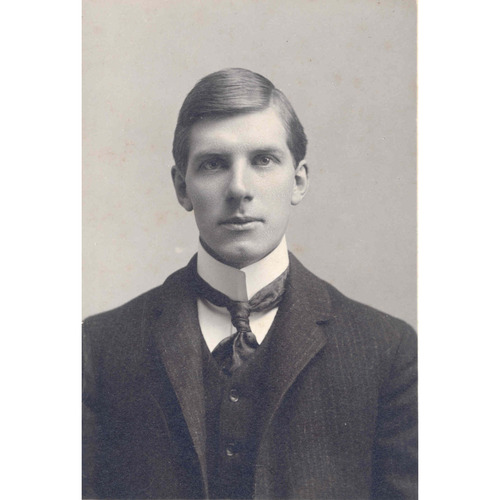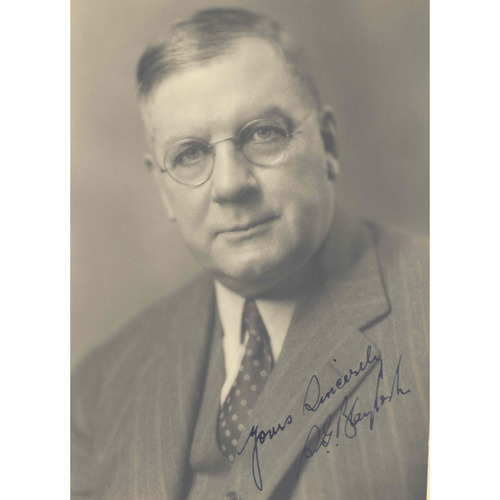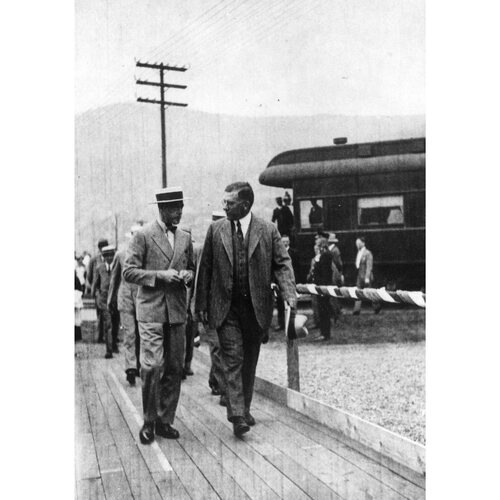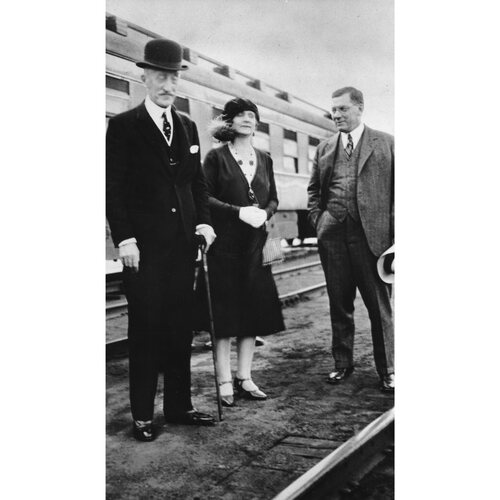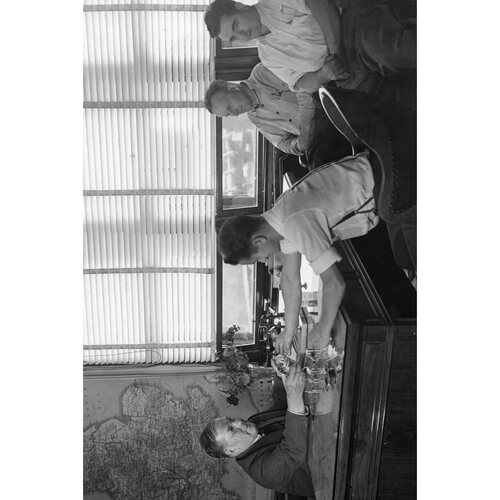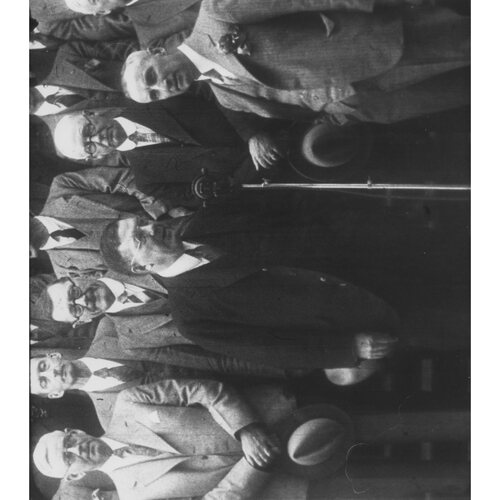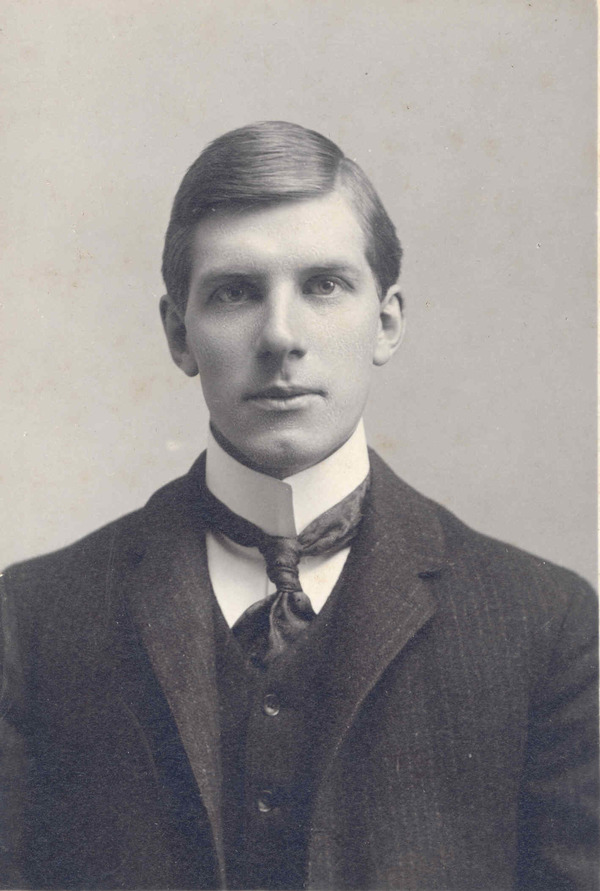
Source: Link
BLAYLOCK, SELWYN GWILLYM, mining engineer and industrialist; b. 18 Feb. 1879 at Paspébiac, Que., son of Thomas Blaylock and Eleanor Mariane Lowndes; brother of Harry Woodburn Blaylock*; m. first 2 Nov. 1904 Ruperta Margaret Riddle (d. 1917) in Danville, Que., and they had two daughters; m. secondly 31 Dec. 1918 Kathleen Louise Riddle (sister of Ruperta Margaret) in Calgary, and they had a son and a daughter; d. 19 Nov. 1945 in Trail, B.C., and was buried in Danville.
Selwyn Gwillym Blaylock was born in Quebec’s Gaspé region to a British-born Anglican clergyman and his Canadian wife. When Selwyn was about nine years old, the family moved to Danville, where his father had been called to continue his ministry. Both Selwyn and his older brother Harry attended Bishop’s College School, a private boarding school in Lennoxville (Sherbrooke), in the 1890s. As reported in the Nelson Daily News, Selwyn once said that he enjoyed rugby because “it taught me to play the game … to take hard knocks and meet disappointments without quitting.” He also excelled at tennis, hockey, and, later, marksmanship. The college fostered his capacity for innovative thinking and his love of team sports, which would influence his future activities in Trail. After graduating from Bishop’s, he moved to Montreal to study mining and metallurgy at McGill University, where he completed a bsc degree in 1899.
Following his studies at McGill, Blaylock relocated to British Columbia to work for the Canadian Pacific Railway Company (CPR) at its smelter, the Canadian Smelting Works, in Trail. The CPR executive board members soon realized that they had acquired a metallurgical genius. At just 20 years old, he began as an assayer. Within two years he was promoted to chief chemist and metallurgist. In 1906 the CPR amalgamated Canadian Smelting Works and several other companies to form the subsidiary Consolidated Mining and Smelting Company of Canada Limited (CM&S), informally known as Cominco (the official name from 1966). The following year Blaylock was appointed general superintendent of a smelter at Nelson, which had once been the Trail smelter’s chief competitor. The following year he took over as general superintendent of the St Eugene Mine at Moyie. He recommended the 1909 purchase of the Sullivan Mine at Kimberley in the East Kootenay district, which would become one of the biggest producers of lead and zinc ore in the world. Blaylock was named assistant general manager of CM&S in 1911, general manager in 1919, a director in 1922, vice-president in 1927, managing director in 1938, and president in 1939. In addition to his work at CM&S, he also held many corporate directorships.
The growth of CM&S’s workforce from 1,000 employees in 1916 to 6,500 in 1937 is a testament to Blaylock’s managerial abilities and a measure of his success. Numerous technical milestones also marked his career. First, he oversaw the development of new zinc-ore processing methods at the Sullivan Mine and the building of the world’s first concentrator to separate lead and zinc by selective flotation. Since rifle shells were made from brass, of which CM&S’s zinc was a key ingredient, the concentrator helped to ensure that soldiers would have a reliable supply of ammunition. Secondly, the company achieved another impressive breakthrough in the late 1920s. In response to public complaints that the Trail smelter was polluting farmland downstream in Washington State, and pressured by an International Joint Commission [see Sir George Christie Gibbons*] ruling that required CM&S to pay damages, the company developed a way to capture toxic sulphur dioxide gases and convert them into the highly profitable Elephant Brand fertilizer. Thirdly, during the Second World War, Blaylock negotiated a contract with the United States army for CM&S to supply heavy water to the Manhattan Project for the testing of the atomic bomb. The heavy-water plant, known by the code name Project 9, would remain a well-kept secret long after the war ended. Ultimately, the product was not used in the bombs that were dropped on Japan in 1945, but Trail’s heavy water would later be used in Canada’s nuclear reactor program. Blaylock had also helped furnish the Allies with war materials thanks to the opening of two new mines in British Columbia, one to produce tungsten, a metal required to manufacture armour-piercing shells, and the other to provide coal for the smelter in Trail. CM&S also operated a mine to meet the need for mercury in bomb detonators. The company refined its production process for tin, another valuable wartime commodity, at Kimberley in 1942. It also produced nitric acid, ammonia, and nitrogen, all products that could be utilized in making explosives.
Business historians agree that Blaylock was a man of cautious foresight and studied action. He never failed to train one eye on what would make shareholders happy. They benefited greatly from his determination to boost efficiency and production during wartime. Net profits had grown from $474,012 in 1914 to $867,259 in 1918. They soared to $9,339,585 in 1939 and $11,517,758 in 1945. In fact, throughout the Second World War, net profits never dropped below the $9 million mark and dividends rose from $6.5 to $8.1 million.
Competitive wages had helped ensure labour peace at CM&S up until the beginning of the First World War, but the arrival in Trail in early 1915 of Albert (Ginger) Goodwin*, a socialist and organizer for the Western Federation of Miners (WFM), invigorated the drive to unionize. The following year the WFM changed its name to the International Union of Mine, Mill and Smelter Workers (also known as Mine Mill) and the majority of CM&S’s workers agreed to join its Local 105. In 1917 Goodwin and other union leaders demanded a pay increase of 50 cents per day to offset the impact of wartime inflation, an eight-hour workday, an automatic system for paying dues, and greater protections against workplace hazards in the smelter. The workers launched a strike in November of that year that lasted 35 days but were ultimately defeated when the union’s leaders in the United States sided with the company and abandoned support for the strike. Employees voted to return to work without any gains. Blaylock had promised that there would be no job losses, but over 500 employees (about half the workforce) were not recalled, and some strike leaders were blacklisted. “If you were on the blacklist,” recalled former worker Gino Tognotti, “you had it.” In 1918 the local Military Service Act tribunal rejected Goodwin’s appeal for an exemption to military service on health grounds. He fled town and was fatally shot later that year by a Dominion Police officer looking for those evading conscription. Some believe, without evidence, that Blaylock had conspired with police to have Goodwin killed.
After the strike, Blaylock created the Workmen’s Cooperative Committee (WCC) in an attempt to crush any future union organization. The WCC, which based its mandate partly on views expounded by Liberal politician William Lyon Mackenzie King in his book Industry and humanity: a study in the principles underlying industrial reconstruction (Toronto and Boston, 1918), was known as a “company union.” For the next 25 years, Blaylock oversaw this cooperative approach to labour management, appointing its members, providing company office space, and chairing its meetings. He believed that the WCC benefited every smelter worker, and consequently all citizens of Trail, by keeping peace in a community of miners, immigrants, churchgoers, bar-hoppers, and a few communists. It was part of his attempt to encourage a sentimental view of Trail as a paradise for workers, where his employees were members of the corporate family. Wage levels matched and sometimes exceeded industry standards, and Blaylock instituted several programs that benefited workers. These included a company share grant (up to five shares), housing loans, subsidized coal and garden allotments, and recreational facilities, as well as sick leave, health insurance (1921), and a pension plan (1926).
On occasion Blaylock’s paternalism won him the respect of some employees, including the time he instituted a ten per cent wage cut and reduced working hours to avoid layoffs during the Great Depression. Such arbitrary actions, however well intentioned, led to increased friction with union organizers. Starting in 1938 there was a renewed push to unionize the workforce. During the Second World War, Blaylock was a tireless supporter of Allied troops, raising hundreds of thousands of dollars in Victory Loans. To do this, he subtracted donations from his employees’ paycheques, a move that drew the ire of those trying to form a union. The drive stalled by early 1943, however, with no more than about 225 out of several thousand employees having joined the union. A major boost came that year when an amendment to British Columbia’s Industrial Conciliation and Arbitration Act banned company unions. There was a breakthrough in early 1944 when King’s federal government issued an order in council that barred employers from interfering with union organizing drives, obliged them to negotiate with representatives elected by workers, and provided some protections for employees during collective bargaining. The majority of smelter workers subsequently joined the International Union of Mine, Mill and Smelter Workers, and Local 480 was certified in 1944. Blaylock was forced by law to negotiate his first collective agreement.
As he rose in public stature, Blaylock had become more engaged in local social and economic organizations, such as the Trail Board of Trade and the Associated Boards of Trade of Southeastern British Columbia. An avid gardener and tree expert, he was an annual award winner at local fruit- and vegetable-growing competitions, and he imported many tree varieties for the botanical gardens at his mansion in Nelson. His enthusiasm for trees landed him in trouble, however, when local residents accused him of bringing blight to the Kootenays through his illegal importation of the Japanese ornamental cherry tree. He was elected to the St Andrew’s Anglican Church committee in 1918, but relations were not always agreeable. In an earlier encounter, the local bishop had refused to sanction his second marriage, arguing that the Church of England would not allow him to wed the sister of his deceased first wife. The couple subsequently married at a Congregational church in Calgary. Blaylock often hosted visits from national and international dignitaries and participated in gatherings of fraternal orders such as the masons and the Grand Lodge of the Benevolent and Protective Order of Elks of the Dominion of Canada. He was an active tennis player and a prize-winning skeet shooter. An unpublished company biography notes that he was “heavy-set” with “a dominant personality,” although he was “very temperate in his habits, being a non-smoker and a non-drinker.”
Blaylock was widely recognized within the national and international mining and metallurgical industries, winning many awards and medals. In 1924 he received the McCharles Prize ($1,000) from the University of Toronto for his role in developing innovative methods for treating lead, zinc, and silver ore. The American Institute of Mining and Metallurgical Engineers presented him with the James Douglas Medal in 1928. The following year McGill awarded him an honorary doctorate, as did the University of Alberta in 1930. He was elected president of the Canadian Institute of Mining and Metallurgy for 1934–35 and received its gold medal in 1940. Four years later the British Institution of Mining and Metallurgy honoured him in the same way.
Blaylock accepted such public accolades modestly, preferring to enjoy his privacy. He suffered from cardiovascular disease for the last 15 years of his life and died of congestive heart failure at age 66 in 1945. Three years later the Canadian Institute of Mining and Metallurgy created an annual award in his honour. In 1990 he was inducted into the Canadian Mining Hall of Fame. A creek in British Columbia bears his name, and his majestic home near Nelson has been converted into a bed and breakfast called the Blaylock Mansion.
Although Blaylock’s accomplishments are not well known outside the Trail area, his life intersected with many corporate and scientific developments that affect all Canadians. Obituaries and eulogies lauded his long service to CM&S and the community. Cominco Magazine, the company newsletter, stated that “his capacity for exciting admiration was unique” and that “no one who knew him could maintain animosity toward him and his personal bigness and integrity was a strong factor in his relations with his employees.” Top company managers like Reuben Ewart Stavert, who succeeded Blaylock, said, “The country has lost one of its leading citizens.” Further praise came from Anglican archdeacon Fred H. Graham, Blaylock’s long-time friend from Nelson, who likened his death to a great tree falling in the forest. Fred Henne, Local 480 president in the 1940s, recognized Blaylock as “a vigorous man with definite ideas and principles, opposed to many of our ideas and principles.” Even so, he affirmed, “We were able to reconcile our thoughts.” Henne was more generous than later commentators. “Blaylock was not the saint portrayed in various books,” wrote local historian Ron Welwood, who criticized his anti-union activities. Despite conflicting opinions, Blaylock was mostly seen as an insightful businessman with a Midas touch who sponsored inventions that yielded substantial profits for CM&S and secured its reputation as the owner of one of the world’s largest lead and zinc smelters. While he was a friend to many in the community, he was a stern opponent of trade unions and an enemy of left-wing activists. A local amateur poet, writing in Local 480’s newsletter, the Commentator, in 1942, dubbed Blaylock “Canada’s Citizen Kane.” While the comparison to the title character of the 1941 film Citizen Kane – a powerful industrialist based on American newspaper magnate William Randolph Hearst – might have rung true to some, others saw Blaylock in another light. In their view Trail would not have prospered as it did without him. Throughout the Great Depression and the Second World War, the CM&S president ensured that the small city thrived and its citizens enjoyed relative security.
Many Trailites have continued to praise Blaylock long after his death. Italians, who made up 60 per cent of CM&S’s workforce in 1910, are especially appreciative. “He was a very kind man,” recalled Lodi Forte, an elderly Italian immigrant, in a 2010 interview. When racial slurs against Italians were commonly heard around Trail, “he was very, very sympathetic.” During the Second World War, he had pledged to protect his Italian employees if they surrendered their firearms, and he treated other southern Europeans, as well as Germans and Austrians, firmly but fairly. He was loyal to Trail, where he is remembered for supporting its famous Smoke Eaters hockey team, which won world amateur hockey championships for Canada in 1939 and 1961. Blaylock is also appreciated for the corporate-welfare programs he established and for his company’s contribution to Trail, including a hospital, community housing, and the Memorial Centre, where the Smoke Eaters junior hockey team continues to play. In Trail he will always be remembered respectfully, and sometimes begrudgingly, as “Mr. Blaylock.”
Ancestry.com, “Alberta, Canada, marriages index, 1898–1944”: www.ancestry.ca/search/collections/61560 (consulted 9 June 2021); “British Columbia, Canada, death index, 1872–1990”: www.ancestry.ca/search/collections/6093 (consulted 9 June 2021); “Quebec, Canada, vital and church records (Drouin coll.), 1621–1968,” Anglican Church (New Carlisle, Que.), 4 May 1879; Anglican Church (Danville, Que.), 2 Nov. 1904: www.ancestry.ca/search/collections/1091 (consulted 30 Nov. 2022). Find a Grave, “Memorial no.73833601,”: www.findagrave.com (consulted 9 June 2021). Private arch., Ron Verzuh (Eugene, Oreg.), Interview with Louis (Gigi) and Lodovica (Lodi) Forte, 10 May 2010. Teck Resources Limited (Trail, B.C.), Cominco files, “Blaylock, Selwyn Gwillym 1879–1945 – limited biography,” and an untitled biography of Blaylock; H. W. Bayley, “Cominco – a historical outline,” January 1976; H. Fargey, “A chronological record of outstanding events in the history of the Consolidated Mining and Smelting Company of Canada, Limited,” January 1949; F. W. Henne to Cominco Magazine editor Lance Whittaker, 20 Nov. 1945; “A portrait of progress: the story of Cominco,” 1981; L. H. Whittaker, “All is not gold: a story of discovery, production and processing of the mineral, chemical and power resources of the Kootenay district of the province of British Columbia and the lives of the men who developed and exploited those resources,” 1945. Calgary Herald, 2 Jan. 1919. Nelson Daily News (Nelson, B.C.), 20 Nov. 1945. Trail Daily Times, 1931–41. Trail News, 1904–25. Canadian Mining Hall of Fame, “Selwyn Gwillym Blaylock (1879–1945)”: www.mininghalloffame.ca/tag/selwyn-blaylock (consulted 9 June 2021). “Death of a captain of industry,” Commentator (Trail), 3 (1942), no.15: 3. “A glimpse at company officials, No. 1 – S. G. Blaylock,” Cominco Magazine (Trail), 2 May 1940: 1. Al King, with Kate Braid, Red bait! Struggles of a Mine Mill local (Vancouver, 1998). Michael Kluckner, “Vanishing British Columbia”: www.michaelkluckner.com/bciw4blaylock.html (consulted 9 June 2021). Jeremy Mouat, The business of power: hydro-electricity in southeastern British Columbia, 1897–1997 (Victoria, 1997); Roaring days: Rossland’s mines and the history of British Columbia (Vancouver, 1995). D. M. Roth, “A union on the hill: the International Union of Mine, Mill and Smelter Workers and the organization of Trail smelter and chemical workers, 1938–1945” (ma thesis, Simon Fraser Univ., Burnaby, B.C., 1991). Stanley Scott, “A profusion of issues: immigrant labour, the world war, and the Cominco strike of 1917,” Labour (Halifax), 2 (1977): 54–78. E. G. Turnbull, Trail between two wars: the story of a smelter city (Victoria, 1980).
Cite This Article
Ron Verzuh, “BLAYLOCK, SELWYN GWILLYM,” in Dictionary of Canadian Biography, vol. 17, University of Toronto/Université Laval, 2003–, accessed December 19, 2025, https://www.biographi.ca/en/bio/blaylock_selwyn_gwillym_17E.html.
The citation above shows the format for footnotes and endnotes according to the Chicago manual of style (16th edition). Information to be used in other citation formats:
| Permalink: | https://www.biographi.ca/en/bio/blaylock_selwyn_gwillym_17E.html |
| Author of Article: | Ron Verzuh |
| Title of Article: | BLAYLOCK, SELWYN GWILLYM |
| Publication Name: | Dictionary of Canadian Biography, vol. 17 |
| Publisher: | University of Toronto/Université Laval |
| Year of publication: | 2024 |
| Year of revision: | 2024 |
| Access Date: | December 19, 2025 |


